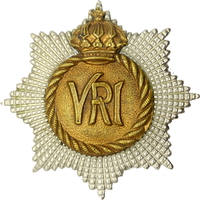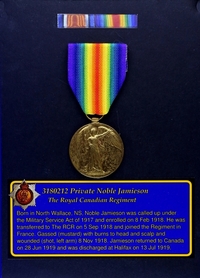
3180212 Private Noble Avard Jamieson
The Royal Canadian Regiment
By: Capt (ret'd) Michael M. O'Leary, CD, The RCR
Noble Avard Jamieson was born in North Wallace, Nova Scotia, on 16 Jul 1889. Jamieson's family, led by parents John and Sabina, can be found in the 1891, 1901, and 1911 Canadian Censuses. The appearances of the family have some not unexpected differences in the recording and transcription of names. In the 1891 Census, John (38) and Sabina (37) have six children ranging in age from 18 to two, with Noble the youngest at the time. By 1901, the eldest son has moved out, and Noble, now 11, has been followed by three younger siblings. In 1911, only three children remain in the family home, Noble (22), Frederick (20), and Hattie (14). In all, Noble Jamieson had 14 siblings, though not all survived their childhood years.
On 8 Feb 1918, Noble Jamieson was called up for service in the Canadian Expeditionary Force (C.E.F.) as a Class One draftee under the Military Service Act of 1917. A 28-year-old farmer, Jamieson was described on his Particulars of Recruit form as 5 feet 7 inches tall, weighing 163 pounds, with good physical development, a 40-inch chest, a dark complexion, blue eyes, and dark hair. His religious denomination was Methodist. Jamieson identified his father, John Jamieson, North Wallace, N.S., as his next of kin. Jamieson was medically examined for his fitness to serve on 1 Feb 1918, and he had been found fit and placed in Category "A-2." Men in Category A-2 were those men who had not been in the field but only lacked training. On enlisting with the C.E.F., Jamieson was taken on the strength of the 1st Depot Battalion, Nova Scotia Regiment at Halifax in Military District No. 6. He was assigned the C.E.F. service number 3180212.
Starting in April 1918, Jamieson assigned $15 of his monthly pay to be sent to his mother. This pay assignment was about half of his pay as a private.
On 7 Apr 1918, Jamieson embarked at Halifax to sail for England aboard the hired military transport ship S.S. Ulua. He disembarked at Liverpool, Eng., on 19 Apr 1918. On arriving in England, Jamieson was taken on the strength of the 17th Reserve Battalion on 20 Apr 1918. He was then shown "On Command," i.e., a temporary duty assignment without changing parent units, to the Segregation Camp at Frenshaw Pond, Bramshott. The Segregation Camp was a measure to control the potential risks of spreading infectious diseases, in particular Influenza, between the populations on either side of the Atlantic. After four weeks in the Segregation Camp, Jamieson reported off command and returned to the 17th Res. Bn. on 25 Jun 1918.
Back home, it was common for local newspapers to print items received by families from overseas as a convenient was to spread news to widespread family and friends. The 9 May 1918 edition of The Truro Weekly News carried a page titled "News From Our Correspondents." In the section of the page for items from Fox Harbour, Cumberland County, was the following entry: "A cable received from Pte. Noble Jamieson, 148 Depot Battalion, N,S.R., to his parents, Mr. And Mrs. J. Jamieson of Mount Wallace, states that he and Pte. Richard Moody of the same Battalion arrived safely in England."
Jamieson proceeded overseas from England to France for service with The Royal Canadian Regiment on 5 Sep 1918. He landed in France the following day and taken on the strength of The RCR while waiting to move up. In a shuffling of reinforcement drafts at the Base Depot, Jamieson was cross-posted from The RCR to the 85th Canadian Infantry Battalion on 11 Sep 1918, and then posted back to The RCR on 2 Oct 1918. Finally, on 4 Oct 1918, he joined the Regiment in the field.
Lasting barely over a month at the front, Jamieson would be on his way rearward days before the Armistice. On 8 Nov 1918, he was wounded by an exploding mustard gas shell, suffering burns to his face and scalp. While the War Diary reports a calm day on 8 Nov, it is the closing lines of the entry for 7 Nov that probably refer to Jamieson's wounding: "After marching into QUIEVRAIN several casualties were caused by shrapnel and gas from enemy bombardment."
On 9 Nov 1918, Jamieson was admitted to No. 10 Canadian Field Ambulance, wounded by gas shell and bullet wound left arm. The following day, he passed through No. 22 General Hospital, Camiers, No. 6 Casualty Clearing Station, and was admitted to No. 22 Western General Hospital
After spending nearly a month in hospital in France, which was possible because the end of the fighting meant a near cessation of new wounded pushing those occupying beds off to England, Jamieson was invalided, wounded, and evacuated to England on 6 Dec 1918. Concurrent with sailing to England aboard the hospital ship H.S. Brighton, Jamieson was posted to the Nova Scotia Regimental Depot (N.S.R.D). The N.S.R.D. was part of a regionally based reinforcement system, with named Depots taking in troops from battalions raised in those areas in Canada and providing reinforcement drafts to similarly designated fighting units. The RCR, having been headquartered in Halifax in the decade before the War, was associated with the N.S.R.D. These Depots also became the parent unit for any soldiers returned to England from their affiliated battalions in France and Flanders.
On 7 Dec 1918, Jamieson was admitted to 2nd Western General Hospital, Manchester, for further treatment of his wounds. Eleven days later, on 18 Dec 1918, he moved again and was admitted to the Canadian Convalescent Hospital, Woodcote Park, Epsom. His case notes at this time, referring to his shell gas poisoning, stated: "Chest clear, expansion good, heart negative, no evidence of disability."
It was after Jamieson had been in England for almost two weeks that news of his condition reached home with any details. The Truro Weekly News edition of 19 Dec 1918 shared the news that Pte. Noble Jamieson of North Wallace, N.S., has been gassed. The following week, on 26 Dec 1918, the same paper carried the following brief item:
"North Wallace Hero Gassed.
"Mr. And Mrs. John Jamieson of North Wallace were officially notified by telegram from the Director of Records Ottawa that their son Pte. Noble Jamieson 31806212 of the 85th Battalion (sic) was gassed in Belgium on Nov 9th. A letter received from him in 18 General Hospital Dannes Camiers B.E.F. dated Nov. 14th states that the Nurse told him that morning he was marked for England. His many friends receive this news with much joy and hope to see him home soon."
Jamieson was discharged from hospital on 6 Jan 1919 and proceeded on leave from 6 to 18 Jan 1919. With his discharge, he was also placed On Command to the 2nd Canadian Convalescent Depot (2nd C.C.D.) at Bramshott. Apparently enjoying his leave too much to hurry back, and probably thinking that discipline might be a little more relaxed now that the war was over, Jamieson overstayed his leave by two days.
As a result of his unauthorized absence, Jamieson was charged and tried on 22 Jan 1919. The charge was "Overstaying sick furlough from 19.50 hrs, 18 Jan 1919 until 14.00 hrs, 20 Jan 1919." The charge was heard by a senior officer and he was found guilty. Jamieson was awarded the punishment of three days Field Punishment No. 2 and two days Pay forfeited by Pay & Allowance Regulations. Total forfeiture, 3 days pay. (The third day's pay that Jamieson forfeited was the loss of pay for the time he was absent, the others being part of the the awarded punishment for being absent.)
The 30 Jan 1919 edition of The Truro Weekly News carried the following news:
"Mr. And Mrs. John Jamieson received a letter from Miss B.M. Smith, Canadian Red Cross Nurse, London, S.W.S., stating that he was hurt by a bursting gas shell and has bits of shell and burns on his head, and that everything possible was being done for his comfort, Private Jamieson sent the following Menu Card for Xmas:
Xmas Day Dinner at Canadian Military Hospital,
Woodcote Park, Epsom, Surrey,
Col. F. Griest, Commandant.
Dinner.
Tomato Soup – Roast Turkey with Dressing –
Mashed Potatoes – Brussel Sprouts with White Sauce –
Plum Pudding with Sauce – Fruits – Nuts.
Tea.
Cold Turkey – Jam – Christmas cake – Fruit – Nuts
Major E.G. Rogers, Officer in Charge Messing.
Jamieson ceased to be attached to the 2nd C.C.D. and was posted to the 17th Res. Bn. on 2 May 1919. Two weeks later, on 15 May 1919, he was medically examined prior to discharge at Ripon. The Medical Examination report noted Jamieson's gassing which affected his eyes and chest but left no disability.
Sailing for Canada on 28 Jun 1919 aboard the troopship H.M.S. Mauretania, Jamieson was struck off the strength of the Overseas Military Forces of Canada to the C.E.F. in Canada. He was taken on the strength of District Depot No. 6, Halifax, N.S.
Jamieson was discharged from the C.E.F. on 13 Jul 1919 at Dispersal Station "B", Military District No. 6, Halifax, N.S. He was issued the Class "A" War Service badge, number 301412. Jamieson was also authorized to wear one wound stripe. The Discharge Certificate received by Jamieson included the following instructions stamped on the back:
"1.—That discharge certificate must be carried when wearing uniform.
"2.—The uniform can be worn only thirty (30) days after discharged, or when only authorized in writing, and
"3.—The wearing of uniform renders him liable to usual military discipline as if on the strength of a unit."
On discharge from the C.E.F., Jamieson was entitled to a War Service Gratuity of $280. This was paid to him in installments between July and October, 1919.
On 20 May 1920, Nobel Jamieson married 23-year-old Yorkshire, Eng., born Mabel Cheetham, a war bride. The couple would have six children, David (b. 1922), Ronald (b. 1925), Betty (b. 1927), Leonard (b. 1930), John (b. 1933), Joan (b. 1938).
For his service in the C.E.F., Jamieson was entitled to receive the British War Medal and the Victory Medal. These were despatched to him at North Wallace, N.S., on 24 Jul 1922.
In January, 1923, it was reported in the local news that Jamieson and his brother, Daniel Obrey Jamieson, had "erected a lobster factory on the Fraser property at North Wallace. They are having two new boats built in preparation for the spring fishing season." With a varied working life, Jamieson is described in some sources as having been a boat-builder. By 1940, he has taken on new employment, and he is identified as the keeper of the Wallace Harbour Range Rear Lighthouse from 1940 until 1958.
Noble Jamieson died on 14 Feb 1972 at Wallace, N.S. His wife, Mabel, survived him by another six years.
Pro Patria
Visit a randomly selected page in The O'Leary Collection (or reload for another choice):
- The O'Leary Collection; Medals of The Royal Canadian Regiment.
- Researching Canadian Soldiers of the First World War
- Researching The Royal Canadian Regiment
- The RCR in the First World War
- Badges of The RCR
- The Senior Subaltern
- The Minute Book (blog)
- Rogue Papers
- Tactical Primers
- The Regimental Library
- Battle Honours
- Perpetuation of the CEF
- A Miscellany
- Quotes
- The Frontenac Times
- Site Map
QUICK LINKS
The O'Leary Collection—Medals of The Royal Canadian Regiment
Newest additions:
![]()
![]() SB-12725 Private Henry "Hank" Ard
SB-12725 Private Henry "Hank" Ard ![]()
WIA at Hill 187, Died of Wounds in Japan
![]()
![]() 2355331 Lance Corporal Albert Lorking
2355331 Lance Corporal Albert Lorking
Wounded in action, later a War Amps representative.
![]()
![]() 4334 / 477996 Pte Isaac Hamilton Wilcox
4334 / 477996 Pte Isaac Hamilton Wilcox
Permanent Force, South Africa, and C.E.F.
![]()
![]() 477019 Private Harold Ashcroft
477019 Private Harold Ashcroft
Transferred to the Tunnelers.
![]()
![]() 734231 Private Clark D. Thompson
734231 Private Clark D. Thompson ![]()
The older Thompson brother, killed in action.
![]()
![]() 733849 Private Norman Parker Thompson
733849 Private Norman Parker Thompson
The younger Thompson brother; post-war service in the Special Guard.
![]()
![]()
![]() A305 / 400305 Private Andrew Walker
A305 / 400305 Private Andrew Walker ![]()
"Previously reported Wounded, now Killed in Action."
![]()
![]() 823298 Pte Thomas Patrick Steele, M.M.
823298 Pte Thomas Patrick Steele, M.M. ![]()
… for gallant conduct in the field …
![]()
![]() P13066 Sergeant Harold Thompson
P13066 Sergeant Harold Thompson
Instrumental Soloist for over 20 years of Canadian Army service.
![]()
![]() 9609 / 477728 Private Albert Edward Piper
9609 / 477728 Private Albert Edward Piper
"Arrived from England as a STOWAWAY …"



